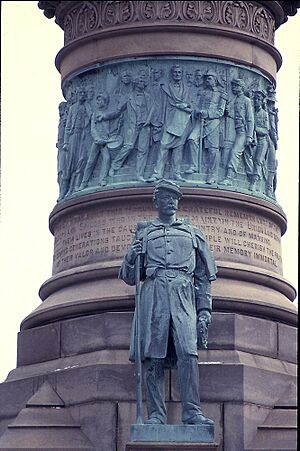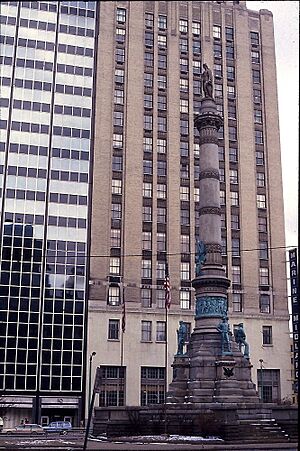Soldiers and Sailors Monument (Buffalo) facts for kids
The Soldiers and Sailors Monument is a special war monument in Lafayette Square, Buffalo, New York. It was created by sculptor Casper Buberl and architect George Keller. This important monument was first shown to the public in 1882.
Contents
What is the Soldiers and Sailors Monument?
This monument has a tall central part that holds a large female figure. She is about 10 feet 6 inches (3.2 meters) tall. There are also four bronze statues, each about 8 feet (2.4 meters) tall. These statues face the four main directions: north, south, east, and west. They represent different parts of the military:
- The infantry (soldiers who fight on foot)
- The artillery (soldiers who use large guns)
- The cavalry (soldiers who fought on horseback)
- The navy (soldiers who fight at sea)
The Monument's Design and Art
The bronze statues were sculpted by Caspar Buberl. Around the main column, above the statues, you can see bronze pictures that stick out from the surface. These are called bas-reliefs. The tall female figure at the top is a "nameless stone lady." She is a symbol of Buffalo itself.
Why Was the Monument Built?
The monument was built to honor brave people. The side of the monument facing Main Street has a special message. It honors those who gave their lives in the war. This war was fought to keep the country united. It was also for the cause of their country and for all people.
Abraham Lincoln and the Civil War
On the east side of the monument, you can read half of Abraham Lincoln's famous Gettysburg Address. This speech was given during the American Civil War. The monument also shows scenes from Lincoln's first group of advisors, called his cabinet. These scenes include important figures like:
- Salmon Chase, who was in charge of the country's money.
- William H. Seward, who handled foreign affairs.
- Edward Bates, the country's top lawyer.
- Montgomery Blair, who managed the mail system.
- Caleb Smith, who looked after the country's lands and resources.
- Gideon Welles, who was in charge of the navy.
- Winfield Scott, a very important general.
- Simon Cameron, who was in charge of the army.



